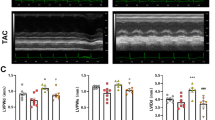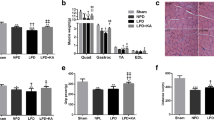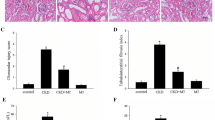Abstract
Objective
Keshan disease (KD) is a myocardial mitochondrial disease closely related to insufficient selenium (Se) and protein intake. PTEN induced putative kinase 1 (PINK1)/Parkin mediated mitochondrial autophagy regulates various physiological and pathological processes in the body. This study aimed to elucidate the relationship between PINK1/Parkin-regulated mitochondrial autophagy and KD-related myocardial injury.
Methods
A low Se and low protein animal model was established. One hundred Wistar rats were randomly divided into 5 groups (control group, low Se group, low protein group, low Se + low protein group, and corn from KD area group). The JC-1 method was used to detect the mitochondrial membrane potential (MMP). ELISA was used to detect serum creatine kinase MB (CK-MB), cardiac troponin I (cTnI), and mitochondrial-glutamicoxalacetic transaminase (M-GOT) levels. RT-PCR and Western blot analysis were used to detect the expression of PINK1, Parkin, sequestome 1 (P62), and microtubule-associated proteins1A/1B light chain 3B (MAP1LC3B).
Results
The MMP was significantly decreased and the activity of CK-MB, cTnI, and M-GOT significantly increased in each experimental group (low Se group, low protein group, low Se + low protein group and corn from KD area group) compared with the control group (P<0.05 for all). The mRNA and protein expression levels of PINK1, Parkin and MAP1LC3B were profoundly increased, and those of P62 markedly decreased in the experimental groups compared with the control group (P<0.05 for all).
Conclusion
Low Se and low protein levels exacerbate myocardial damage in KD by affecting the PINK1/Parkin-mediated mitochondrial autophagy pathway.
Similar content being viewed by others
References
Shi Y, Yang W, Tang X, et al. Keshan disease: a potentially fatal endemic cardiomyopathy in remote mountains of China. Front Pediatr, 2021,9:576916
Loscalzo J. Keshan disease, selenium deficiency, and the selenoproteome. N Engl J Med, 2014,370(18):1756–1760
Yang FY. Keshan disease and myocardial mitochondrial disease. Sci China C Life Sci, 2006,6:481–485
People’s Republic of China industry health standards (2011). The Criteria for Diagnosis of Keshan Disease (WS/T 210-2011)
Li GS, Wang F, Kang D, et al. Keshan disease: an endemic cardiomyopathy in China. Hum Pathol, 1985,16:602–609
Hou J, Zhu LF, Chen CC, et al. Association of selenium levels with the prevention and control of Keshan disease: A cross-sectional study. J Trace Elem Med Biol, 2021,68:126832
Liao YJ, Yu SQ, Guo CF, et al. A comparative study on the epidemic situation of Keshan disease in different ecological disease areas from 1990 to 2007. Foreign Med, 2011,32(1):22–27
Sun SQ. In: Sun DJ, eds. Endemiology. Beijing: People’s Medical Publishing House, 2011:182–190.
Yan C, Luo R, Li F, et al. The epidemiological status, environmental and genetic factors in the etiology of Keshan disease. Cardiovasc Endocrinol Metab, 2020,10(1):14–21
Chen SX, Yang GQ, Chen JS, et al. Studies on the relations of selenium and Keshan disease. Biol Trace Elem Res, 1980,2(2):91–107
Wang XH, Xiang YZ, Qu FR, et al. A study on the relationship between selenium nutritional levels in the internal and external environment and the incidence of Keshan disease. Chin J Endem Dis Prev Control (Chinese), 2005,20:351–353
Morales CR, Pedrozo Z, Lavandero S, et al. Oxidative stress and autophagy in cardiovascular homeostasis. Antioxid Redox Signal, 2014,20(3):507–518
Peng X, Fan P, Wu XT, et al. Research progress on mitochondrial morphological changes and the involvement of the pink1/parkin pathway in mitochondrial autophagy. Modern Med, 2019,47:483–487
Liang RZ, Wang TC, Lin DW, et al. Apelin-13 promotes mitochondrial autophagy by blocking the PINK1/parkin signaling pathway to improve myocardial ischemiareperfusion injury in rats. Xi Bao Yu Fen Zi Mian Yi Xue Za Zhi (Chinese), 2023,39(11):981–987
Li YF, Xie YY, Xu SX, et al. Research progress on mitochondrial autophagy and cardiac energy metabolism. Chin J Geriatr Cardiovasc Dis (Chinese), 2019,21:320–323
Zhang LW, Gao YH, Feng HQ, et al. Effects of selenium deficiency and low protein intake on the apoptosis through a mitochondria-dependent pathway. J Trace Elem Med Bio, 2019,56:21–30
He S, Guo X, Tan W, et al. Effect of Selenium Deficiency on Phosphorylation of the AMPK Pathway in Rats. Biol Trace Elem Res, 2016,169(2):254–260
Livak KJ, Schmittgen TD. Analysis of relative gene expression data using real-time quantitative PCR and the 2(-Delta Delta C(T)) method. Methods, 2001,25(4):402–408
Gu BQ, Cui KX, Yang JH, et al. The effects of low selenium on the morphological structure of rat liver, heart, and skeletal muscles. J Shanghai First Med Coll (Chinese), 1985,5:350–354, 402–403
Zeng XH, Zhou BC, Chi YM, et al. The damaging effect of protein deficiency on myocardium under low selenium and high manganese conditions. Chin J Endem Dis (Chinese), 1996,6:330–333
Gao YH, Liu MN, Zhou LW, et al. Experimental observation of T-2 toxin induced myocardial injury in low selenium and low protein rats. Zhongguo Difangbingxue Zazhi (Chinese), 2003,3:17–20
Yu WH, Zeng XH, Zhou BC et al. Experimental study on myocardial injury in rats induced by selenium deficiency and manganese enrichment and its protective factors. Zhongguo Difangbingxue Zazhi (Chinese), 1991,1:3–9
Zhou Lw, Pei JR, Li XR, et al. Experimental study on myocardial injury in rats caused by low selenium and low nutrient complex factors. Zhongguo Difangbingxue Zazhi (Chinese), 2007,26(4):361–363
Sun SZ, Zhou RH, Gu LZ, et al. The Effect of Dietary Protein Levels on Selenium Utilization II. The Influence of Dietary Protein Levels on Selenium Content and Glutathione Peroxidase Activity in Blood and Tissues of Experimental Animals. J Nutr, 1983,2:145–150
Ti BX, Han FS, Yu WH. Protective effect of protein on myocardial injury in rats fed with grains from Keshan disease endemic area. Zhongguo Difangbingxue Zazhi (Chinese), 2002,4:6–9
Jiang KB, Wu QQ, Shen DF. Research progress on mitochondrial dysfunction and ejection fraction preserving heart failure. J Med Res, 2023,52(06):6–10
Wang S, Kandadi MR, Ren J. Double knockout of Akt2 and AMPK predisposes cardiac aging without affecting lifespan: Role of autophagy and mitophagy. Biochim Biophys Acta Mol Basis Dis, 2019,1865(7):1865–1875
Yang M, Wang S, Fu S, et al. Deletion of the E3 ubiquitin ligase, Parkin, exacerbates chronic alcohol intake-induced cardiomyopathy through an Ambra1-dependent mechanism. Br J Pharmacol, 2021,178(4):964–982
Ajoolabady A, Aslkhodapasandhokmabad H, Aghanejad A, et al. Mitophagy Receptors and Mediators: Therapeutic Targets in the Management of Cardiovascular Ageing. Ageing Res Rev, 2020,62:101129
Chen DG. Keshan disease and Kashin Beck disease caused by selenium deficiency. Health Literature, 2020,(5):95–96
Li JH, Gui YM. The effects of dietary protein levels and organic selenium supplementation time on the growth performance and muscle selenium deposition of broiler chickens. J Chin Agri Univ, 2008,5:81–87
Saha S, Panigrahi DP, Patil S, et al. Autophagy in health and disease: A comprehensive review. Biomed Pharmacother, 2018,104:485–495
Mizushima N, Komatsu M. Autophagy: renovation of cells and tissues. Cell, 2011,147(4):728–741
Tahrir FG, Langford D, Amini S, et al. Mitochondrial quality control in cardiac cells: Mechanisms and role in cardiac cell injury and disease. J Cell Physiol, 2019,234(6):8122–8133
Pires J, Haynes CM. Mitochondrial Biogenesis: MitoCPR Resuscitates Import-Defective Mitochondria. Curr Biol, 2018,28(11):R669–R671
Sato S, Furuya N. Induction of PINK1/Parkin-Mediated Mitophagy. Methods Mol Biol, 2018,1759:9–17
Mohamud Y, Qu J, Xue YC, et al. CALCOCO2/NDP52 and SQSTM1/p62 differentially regulate coxsackievirus B3 propagation. Cell Death Differ, 2019,26(6):1062–1076
Wang B, Nie J, Wu L, et al. AMPKα2 Protects Against the Development of Heart Failure by Enhancing Mitophagy via PINK1 Phosphorylation. Circ Res, 2018,122(5):712–729
Eid N, Kondo Y. Parkin in cancer: Mitophagy-related/unrelated tasks. World J Hepatol, 2017,9(7):349–351
Liang DY, Dai HC. The role of PINK1/Parkin pathway in mitochondrial autophagy oxidative damage. Chin J Cell Biol (Chinese), 2018,40(01):116–123
Hollville E, Carroll RG, Cullen SP, et al. Bcl-2 family proteins participate in mitochondrial quality control by regulating Parkin/PINK1-dependent mitophagy. Mol Cell, 2014,55(3):451–466
Johnson BN, Berger AK, Cortese GP, et al. The ubiquitin E3 ligase parkin regulates the proapoptotic function of Bax. Proc Natl Acad Sci USA, 2012,109(16):6283–6288
Chen D, Gao F, Li B, et al. Parkin mono-ubiquitinates Bcl-2 and regulates autophagy. J Biol Chem, 2010,285(49):38214–38223
Poole AC, Thomas RE, Andrews LA, et al. The PINK1/Parkin pathway regulates mitochondrial morphology. Proc Natl Acad Sci USA, 2008,105(5):1638–1643
Geisler S, Holmström KM, Skujat D, et al. PINK1/Parkin-mediated mitophagy is dependent on VDAC1 and p62/SQSTM1. Nat Cell Biol, 2010,12(2):119–131
Schaaf MB, Keulers TG, Vooijs MA, et al. LC3/GABARAP family proteins: autophagy-(un)related functions. FASEB J, 2016,30(12):3961–3978
Author information
Authors and Affiliations
Corresponding author
Ethics declarations
The authors declare that there is no conflict of interest with any financial organization or corporation or individual that can inappropriately influence this work.
Additional information
This research was supported by the Natural Science Foundation of Heilongjiang Province (No. LH2021H009).
Rights and permissions
About this article
Cite this article
Zhang, Lw., Feng, Hq., Fu, Sb. et al. Low Selenium and Low Protein Exacerbate Myocardial Damage in Keshan Disease by Affecting the PINK1/Parkin-mediated Mitochondrial Autophagy Pathway. CURR MED SCI 44, 93–101 (2024). https://doi.org/10.1007/s11596-024-2834-x
Received:
Accepted:
Published:
Issue Date:
DOI: https://doi.org/10.1007/s11596-024-2834-x




